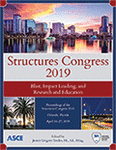Structures Congress 2019
Parametric Evaluation for Balanced Design Considerations of Blast-Resistant Windows
Publication: Structures Congress 2019: Blast, Impact Loading, and Research and Education
ABSTRACT
The principle of balanced design was developed to control the manner of failure in window systems such that the glass would fail before more catastrophic and damaging failure of anchorage or building substrate. When static loads are considered, determining the capacity of a pane of glass is straightforward. However, when dynamic loads are considered the capacity of the glass is a function of peak pressure, load duration, and load shape. All of these parameters vary with charge weight and standoff. Blast-resistant criteria and design specifications frequently require a balanced design for window systems, in particular. The response of a window system can change significantly depending on how the capacity load of the window system is determined and defined. Based on a review of representative blast-resistant windows evaluated analytically and through explosive testing, key factors are provided for consideration by designers and specification writers to improve balanced design of window systems while maintaining the level of protection required for blast-resistant projects.
Get full access to this article
View all available purchase options and get full access to this chapter.
References
Alexander, Q., Brock, S., and Bryant, L. (2014). “Balanced Design for Blast-Mitigating Window Retrofits for Historic Structures.” ASCE, Reston, VA.
ARA (Applied Research Associates, Inc) for General Services Administration. (2005). Window Glazing Analysis Response & Design (WINGARD), A National Standard for the Prediction of Glazing Response and Hazards, Technical Manual, ARA-TR-05-16462-2. ARA, Vicksburg, MS.
Bryant, L., Erekson, J., Herrle, K. (2013). “Are You Positive About Negative Phase?” Conference Proceedings, Structures Congress 2013, ASCE, Reston, VA. 103-114.
DOD (U.S. Department of Defense). (2013). DoD Minimum Antiterrorism Standards for Buildings. UFC 4-010-01, DOD, Washington, DC.
FEMA (Federal Emergency Management Association). (2003). Primer for Design of Commercial Buildings to Mitigate Terrorist Acts, FEMA 427. FEMA, Washington, DC.
Norville, H.S., Harvill, N., Conrath, E., Shariat, S. and Mallonee, S. (1999). “Glass-Related Injuries in Oklahoma City Bombing.”, Journal of Performance of Constructed Facilities, 13(2).
Stone Security Engineering, PC for General Services Administration. (2011). General Services Administration Facility Security Requirements for Explosive Devises Applicable to Facility Security Levels III and IV. New York, NY.
U.S. Army Corps of Engineers Protective Design Center. (2012). Blast Resistant Design Methodology for Window Systems Designed Statically and Dynamically, PDC-TR 10-02, Omaha, NE.
Information & Authors
Information
Published In
Structures Congress 2019: Blast, Impact Loading, and Research and Education
Pages: 147 - 157
Editor: James Gregory Soules, McDermott International
ISBN (Online): 978-0-7844-8224-7
Copyright
© 2019 American Society of Civil Engineers.
History
Published online: Apr 22, 2019
Published in print: Apr 22, 2019
Authors
Metrics & Citations
Metrics
Citations
Download citation
If you have the appropriate software installed, you can download article citation data to the citation manager of your choice. Simply select your manager software from the list below and click Download.
